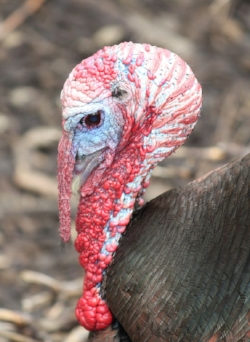Photo credit: Ltshears (Own work) CC BY-SA 3.0 (http://creativecommons.org/licenses/by-sa/3.0) or GFDL (http://www.gnu.org/copyleft/fdl.html) via Wikimedia Commons
You wouldn’t think that turkeys have much reason to be thankful given their place as the centerpiece of Thankgiving dinner, but since their decline to near extinction in the 1930's, turkeys in the Blue Ridge are a wildlife management success story.
The eastern wild turkey, Meleagris gallopavo, is a majestic native of North America. When Europeans came to this continent, they were overwhelmed by the diversity of flora and fauna and wild turkey quickly became a staple in their diet. As human populations grew and forests were cleared, turkeys were over-hunted and almost completely eliminated.
In the 1900s, wild turkey populations were plummeting in the Southeast. Prime turkey habitat (grassy forest edges with abundant seed and insect forage, with adjoining mature oak/hickory forests to provide winter food and nighttime roosting) was diminishing at an alarming rate. The National Wild Turkey Federation estimates there were 10 million turkeys when European settlers arrived, and the population had dwindled to less than 200,000 at its low point in the 1930’s.
Turkeys are not great in flight, but can run short distances at very fast speeds. They are extremely wary, and have extraordinary eyesight and hearing, which makes them difficult to hunt and a real prize to hunters.
Turkeys are the quintessential omnivores: they will eat anything. Plants (roots, buds, stems, leaves, fruit), insects, small amphibians and reptiles, small mammals (mice, voles, moles), at times, even aquatic plants and fish!
In the spring, females lay their camouflaged eggs in a depression and sit on the nest for nearly a month. A common sight in the spring is a hen with her brood moving quickly across your path and into the forest for cover.
Photo credit: Kevin Cole from Pacific Coast, USA (Turkies-2) [CC BY 2.0 (http://creativecommons.org/licenses/by/2.0)], via Wikimedia Commons
The wild turkey has made a great comeback in the last few decades. State wildlife officials began trapping and relocating wild turkeys to increase their distribution- almost 900 birds have been trapped and relocated throughout Virginia. Turkey populations are continuing to increase at an annual rate of about 3%. Hunting regulation and reintroductions have produced a North American thriving flock that is nearly the size of the population before North America was colonized. Turkeys have a lot to be thankful for.
Blue Ridge Discovery Center is thankful for all of the staff, volunteers, and donors who support our mission to inspire curiosity, discovery and stewardship through the wonders of the Blue Ridge. With you, we envision a world with a deep understanding and appreciation of place.
Learn more online, and listen to turkey calls http://www.audubon.org/field-guide/bird/wild-turkey
Photo credit: Teddy Llovet - Morro Bay, CA, USA, creative commons, https://www.flickr.com/photos/teddyllovet/2644580914



![Photo credit: Kevin Cole from Pacific Coast, USA (Turkies-2) [CC BY 2.0 (http://creativecommons.org/licenses/by/2.0)], via Wikimedia Commons](https://images.squarespace-cdn.com/content/v1/5134071fe4b0b73e5291149b/1479939498421-UOU7LUFUFQ9SQ491HG3E/Wild_turkey_with_chicks.jpg)







